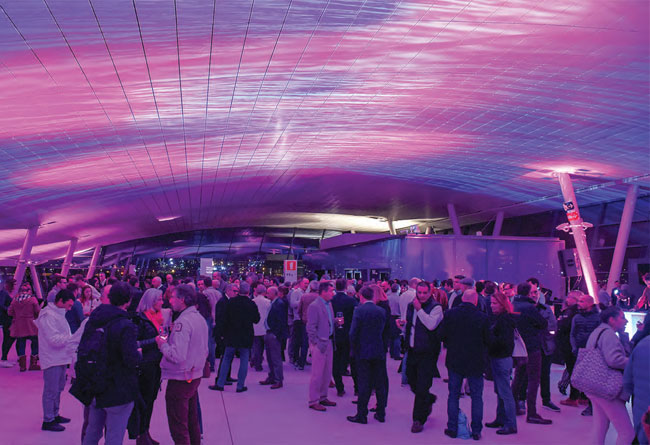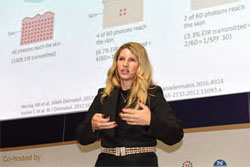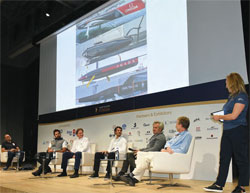

The latest Yacht Race Forum in Bilbao was another chance to catch up with as well as influence every possible aspect of international competitive sailing
Around 365 delegates from all over the world joined the Yacht Racing Forum in Bilbao, Spain, for two days of conferences, presentations, networking and business. The leading classes and regattas, teams, brands and venues contributed to the event, designated by many attendees as “the best YRF ever”.
“The pace of change in the sport of sailing is moving quicker than ever’. This is one of the key messages that came out of this year’s Yacht Racing Forum in Bilbao. One of the sport’s brightest minds, Stan Honey, opened the two-day conference with an inspiring keynote speech that made a few predictions for the next decade. A winning navigator of the Volvo Ocean Race among many other sailing accolades, the multi-Emmy Award winner has been even more successful in developing technology for sports broadcasting including the Liveline technology that has revolutionised coverage of the America’s Cup.
The advent of foiling will open up the opportunity to take all the big offshore records, Honey predicted. Smartphones are now becoming so powerful that the kind of Liveline technology that was only affordable by the America’s Cup could trickle down to grassroots sailing. ‘We developed an electronic umpiring system for AC34, but the technology is becoming so affordable that my next prediction is that electronic umpiring will have a big impact across the sport.’
Honey’s other prediction, that the already meteoric growth in doublehanded offshore racing will continue to rise, was echoed by other speakers at the Forum including Rodion Luka, founder of the L30 keelboat, which is opening up opportunities for aspirants to the new Olympic event for the Marseille Olympics in 2024, mixed two-handed offshore racing. In similar fashion, Dawn Riley explained how Oakcliff Sailing has repurposed a fleet of Melges 24s for affordable two-up offshore competition.
“Professional sailors need to be great storytellers as well as good athletes”, was another of the key messages to come out of day one. If anyone can tell a story that will keep you on the edge of your seat it’s Don McIntyre, who laid out his vision for the Ocean Globe Race, designed to mirror and honour the tradition of the glory days of the Whitbread Round the World Race. Meanwhile Johan Salen is re-envisioning the round-theworld concept with The Ocean Race and he described the exciting future that encapsulates the VO65s and the outlandish foiling Imoca 60s. The builder of the recently launched Hugo Boss Imoca 60, Jason Carrington, reminded delegates that there is nothing cheap about high performance, describing the giant foil that protrudes out of each side of Alex Thomson’s 60 footer as like ‘having a Ferrari strapped to each side of the boat’.
The Yacht Racing Forum has always been a pioneer and advocate of social and environmental change in the sport. Vicky Low presented her research into women’s role in sailing, and her findings reveal that however far gender equality and parity has come in the past few years, it still has a long way to go. Jeremy Pochman of 11th Hour Racing and his panel addressed the business potential of sustainability. Far from being scared of the whole notion of sustainability, Pochman argued that the business opportunities in embracing sustainability are immense.
The Forum concluded with the Top of the Sport, culminating in a star-studded panel to discuss the current America’s Cup cycle. Juan Kouyoumdjian voiced his doubts about the direction taken by the Cup. ‘If you look at the AC75 from a concept point of view, utterly brilliant, but when you look at what we needed to do as a successful Cup, I’m not so sure. If you zoom into what an AC75 is, the notion of having battery or energy dependent systems, for accumulation of energy, I think that we could have looked at achieving that in a much more efficient way.’
As for the sailing itself, a Spanish sailor with Ineos Team UK, Olympic Champion Xabi Fernandez, predicted some great leaps forward: ‘Right now it looks very far away, but I’m pretty sure everyone will end up sailing dry laps. Everything is possible; we were told the foiling gybe would never happen, the foiling tack would never happen, that you can’t match race in a catamaran, but we have proved all these things wrong. My hope for this Cup is that we will see proper racing, which is always a challenge with a new design concept.’
As a concurrent part of the Yacht Racing Forum, the Design and Technology Symposium (DTS) brings together the brightest minds in the industry to discuss the innovations that drive the opportunities for exciting racing discussed in the Forum. For one day, techniques in the design and fabrication of modern high-strength composites used in masts and rigging, boats, appendages and even sails are typical topics in the never-ending quest for greater efficiencies in performance.
Chaired by Luca Rizzotti of Foiling Week, this year’s panel discussion on foiling technology focused on detailed use of robotic machinery in the fabrication of foils where the extreme loads and complex geometries demand absolute precision, and control systems need the reliability to coax the maximum repeatable performance from foiling, whether on a Moth or in the America’s Cup. The audience of 80- 100 was also treated to insights from Martin Fischer on the foil design process used in the development of the just-launched foiling monohull for the Luna Rossa Prada Pirelli America’s Cup team.
The foiling theme continued with a discussion of how this technology can be applied successfully to the design of luxury cruising catamarans that also stray occasionally into racing use, and drag reduction in the aero realm was the theme of Future Fibres’ Jonathan Duvall’s presentation on composite rigging.

Above: Dr Edit Olasz Harken highlights the dangers the sun presents to sailors – and the special risks of products containing ingredients that are now harming the world’s corals ... as well as the world’s humans. The 2019 Forum culminated with a star studded panel (below) to discuss the America’s Cup with Xabí Fernandez, Shanon Falcone, Ken Read, Francis Hueber, Juan Kouyoumdjian and Manolo Ruiz de Elvira

Following a discussion of the marriage of modern sail materials and design to yacht design and fabrication, a discussion led by North Sails’ president Ken Read explained North’s approach to cableless furling headsails and the tremendous promise they hold for improving the speed and shape retention built into these sails. The clever layout of high-strength fibres built into these sail systems also promises vast improvements in the deployment and furling experience for all big-boat sailors, from local inshore club racers to offshore and oceanic greyhounds to the world of superyachts.
Clever product innovations and applications in reducing parasitic chafe and friction was examined in a session presented by Pietro Parmeggiani from PROtect Tapes, and considerations of sustainability inherent to material use in boatbuilding were discussed by William Jelbert from Gunboat.
Moderated by Seahorse Magazine technical editor Dobbs Davis, a lively discussion was held among prominent designers, builders and technologists to examine trends in how Imoca designs may be influenced by shared use of these boats in the upcoming Ocean Race. Are they the same? The consensus is that it’s yet too early to tell completely, so watch this space…
And now that four teams have boats launched for the America’s Cup, another panel of designers, sailors, builders and suppliers shared their thoughts on how the sailors will best handle these challenging boats. Here the consensus is that the simulators are doing a fairly good job, and even though the current learning curve is steep as manoeuvres are worked through by the teams, everyone thinks by the time racing starts all will be ready and the focus will once again return to speed.
Perhaps the most exciting innovation to the DTS this year was in looking ahead not just to the latest in boats, sails and systems, but to the talent that will drive their development into the future. With help from Dr Ignazio Maria Viola of the School of Engineering at the University of Edinburgh, Dr Patrick Bot from Ecole Navale in France and Dr Sandy Day from the University of Strathclyde, six graduate students from these and other schools were selected to give short presentations on their thesis projects to the DTS, followed by numerous networking opportunities as part of this conference.
‘This was a tremendous idea,’ said Jonathan Duvall of Future Fibres. ‘We regularly have interns and are always looking for smart, motivated people to join our team.’ ‘This was a great start to what I hope will be a stronger partnership,’ said Dr Viola. ‘The industry needs bright young minds, and we need to have project ideas to put these minds to work, so I foresee this having great potential to forge an important bridge between the academic and industrial worlds of sailing.
Next year’s Yacht Racing Forum will take place in Portsmouth, UK, on 23-24 November, 2020.
Click here for more information on Yacht Racing Forum »
We invite you to read on and find out for yourself why Seahorse is the most highly-rated source in the world for anyone who is serious about their racing.
To read on simply SIGN up NOW
Take advantage of our very best subscription offer or order a single copy of this issue of Seahorse.
Online at:
www.seahorse.co.uk/shop and use the code TECH20
Or for iPad simply download the Seahorse App at the iTunes store


